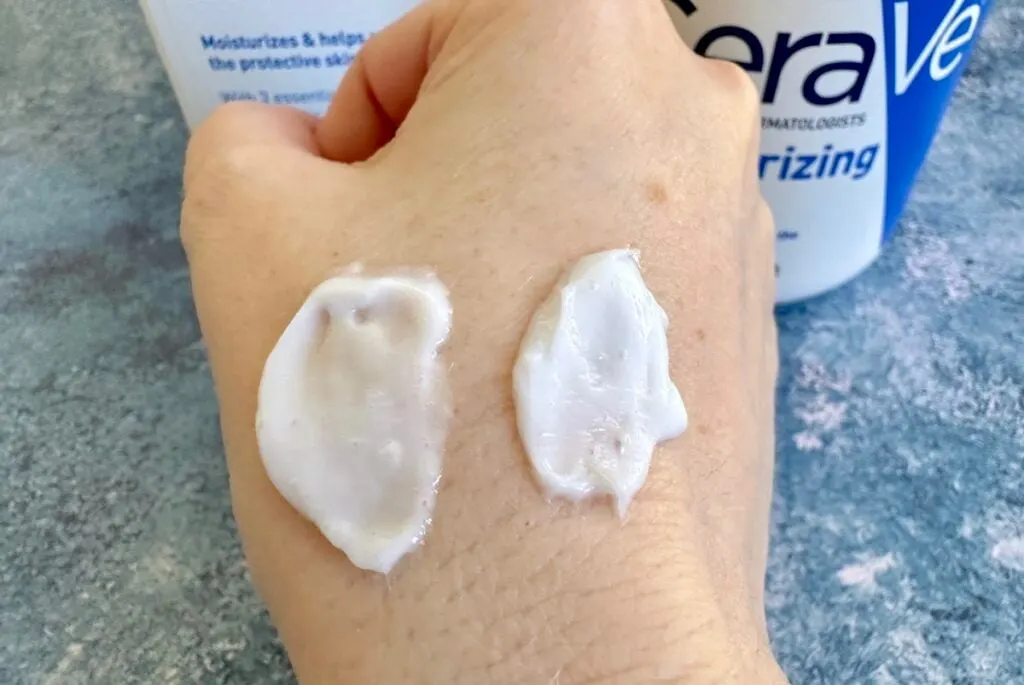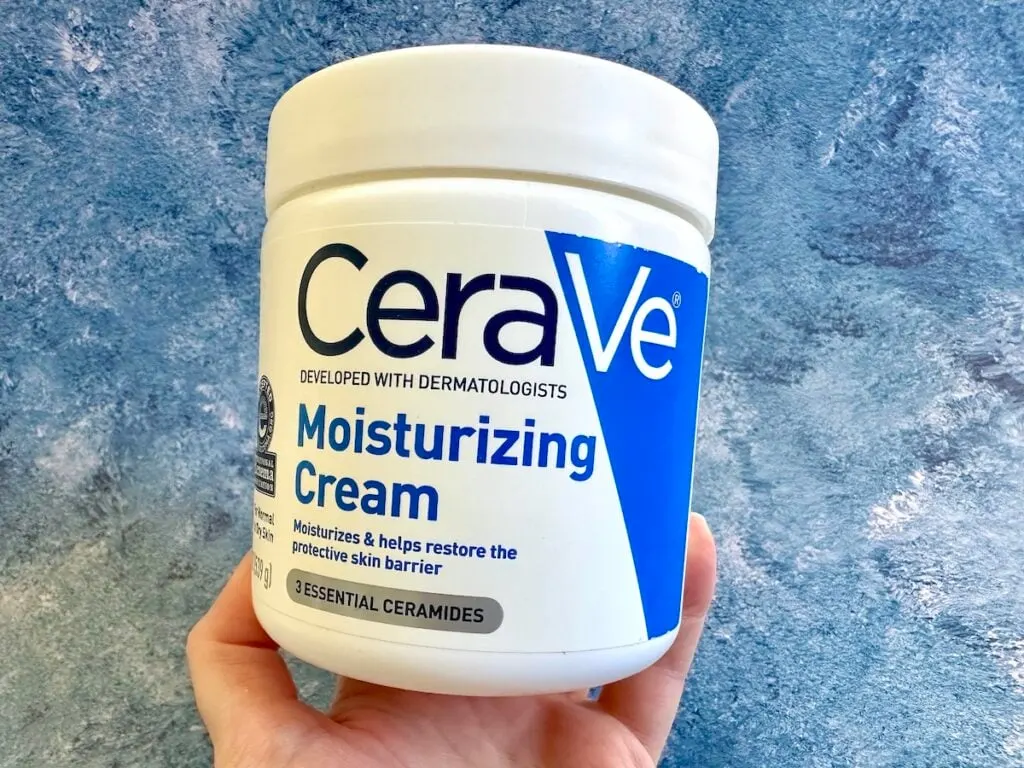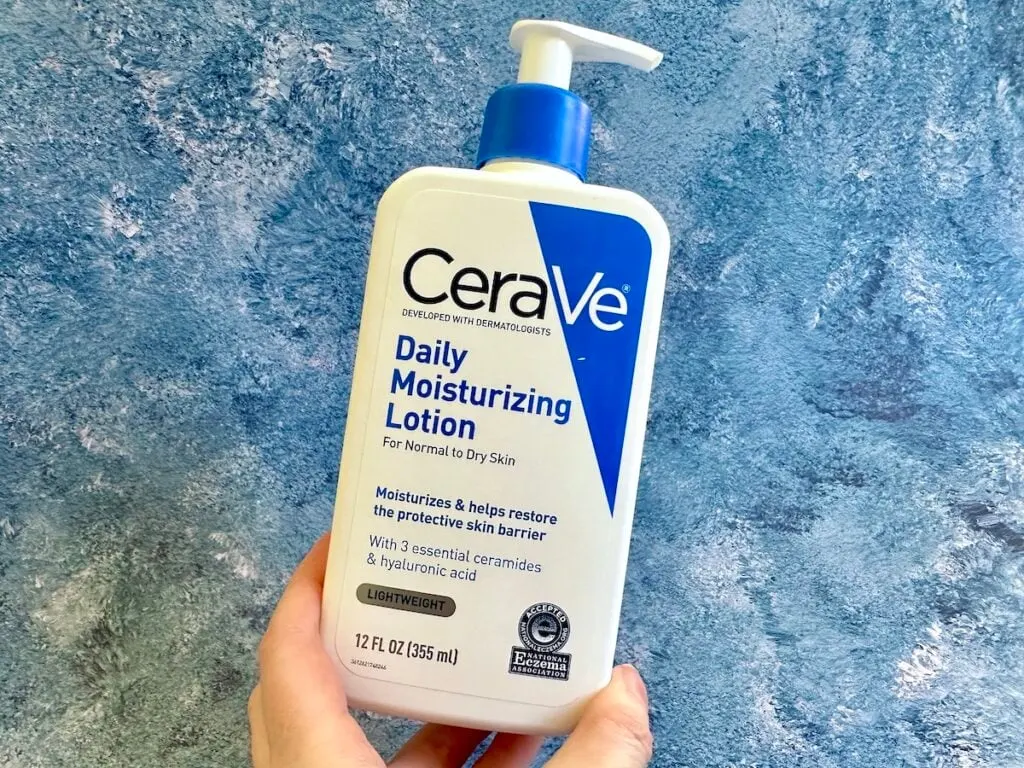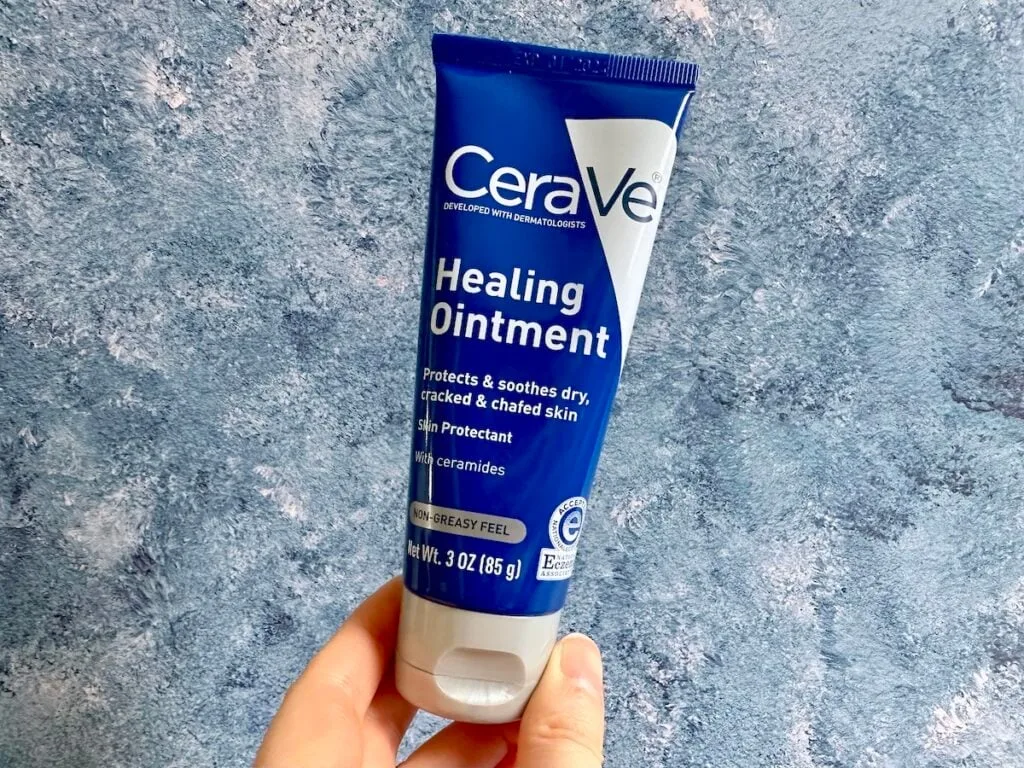It’s no secret that CeraVe skincare products are an excellent choice for moisturizing dry skin. But did you know there are several CeraVe moisturizers? CeraVe Moisturizing Cream and CeraVe Daily Moisturizing Lotion are two CeraVe moisturizers with many similarities, but each has unique skin benefits.
So in this post, we’ll compare CeraVe Moisturizing Cream vs Lotion to help you determine which one is right for your skin type and skin concerns.

We’ll dig a little deeper into these two CeraVe products and compare ingredients, benefits, and drawbacks to help you determine which moisturizer is best for your skin type and skincare needs.
In the following table, we’ll take a quick look at the main similarities and differences between each CeraVe product and then dive into product details.
This post contains affiliate links, and any purchases made through these links will result in a commission for me at no extra cost to you. Please read my Disclosure for additional information.
CeraVe Moisturizing Cream vs Lotion
If you look at CeraVe Moisturing Cream and CeraVe Daily Moisturizing Lotion, you’ll see that they have more similarities than differences.
So which one should you choose? Here are some things to consider about these two CeraVe products:
| Similarities | Differences |
|---|---|
| ✅ Contain 3 essential ceramides, glycerin, cholesterol, and phytosphingosine | ✅ Cream has a richer, heavier texture |
| ✅ Non-comedogenic | ✅ Lotion is oil-free |
| ✅ Fragrance-free | ✅ Lotion is suitable for Normal to Dry Skin; Cream is suitable for Normal to Very Dry Skin |
| ✅ Can be used on the face and body | ✅ Lotion contains hydrolyzed hyaluronic acid; Cream contains sodium hyaluronate |
| ✅ Formulated with CeraVe’s MVE Technology | |
| ✅ Accepted by the National Eczema Association |
Similarities Between Cerave Moisturizing Cream and Lotion
Both the cream and the lotion contain three essential ceramides (Ceramide NP, Ceramide AP, Ceramide EOP) and other nourishing actives like glycerin, cholesterol, and phytosphingosine, that work together to moisturize the skin and help restore and maintain the skin’s natural barrier.
Both the cream and lotion contain dimethicone, a skin protectant and silicone-based polymer that leaves your skin feeling soft and smooth.
Both formulas are fragrance-free and non-comedogenic, so they won’t clog your pores or cause breakouts.
While the cream and lotion are classified as body moisturizers on CeraVe’s website, they are suitable for both the face and body.
Both the cream and lotion are formulated with CeraVe’s proprietary MultiVesicular Emulsion Technology (MVE), a patented delivery system that helps the skin retain moisture over time for long-lasting hydration.
The cream and the lotion have been awarded the National Eczema Association Seal of Acceptance, making them suitable for eczema-prone skin.

Differences Between Cerave Moisturizing Cream and Lotion
The most noticeable visible difference between CeraVe Moisturizing Cream and Cerave Daily Moisturizing Lotion is that the cream has a thicker texture (see image above).
The lotion is formulated for normal to dry skin, while the cream is formulated for normal to dry and very dry skin.
If your skin is very dry, you may find the cream more effective at moisturizing your skin. If you have oily or acne-prone skin, you may find that the lotion works better.
The lotion is oil-free, while the cream contains petrolatum, better known as Vaseline or petroleum jelly, a mix of mineral oils and waxes.
While both the Cream and Lotion are available in multiple sizes, the larger size lotions come in pump bottles, while the cream comes in a tube or a tub.
Hydrolyzed Hyaluronic Acid vs Sodium Hyaluronate
Sodium hyaluronate, the sodium salt version of hyaluronic acid, is found in CeraVe Moisturizing Cream. It has a lower molecular weight than hydrolyzed hyaluronic acid, which is in the Daily Moisturizing Lotion.
Sodium hyaluronate’s lower molecular weight means it can penetrate deeper into the skin, providing more intense hydration.
Let’s look at the ingredients and benefits of each moisturizer:
CeraVe Moisturizing Cream

CeraVe Moisturizing Cream is a rich, fragrance-free moisturizer designed to restore and protect your delicate skin barrier with replenishing active ingredients.
This silky CeraVe moisturizer is non-greasy, absorbs easily, and, although very nourishing, does not feel heavy on the skin.
CeraVe Moisturizing Cream Key Ingredients
Glycerin: Glycerin is a common (an underrated) skincare ingredient that helps draw moisture from the environment into your skin. It supports a healthy skin barrier while protecting your skin from irritation. This clinical study determined that higher glycerin levels in the skin are linked to improved skin hydration.
Petrolatum: Also known as petroleum jelly or Vaseline, petrolatum is an occlusive (water-proofing) ingredient that helps to protect your skin from moisture loss.
Derived from petroleum, petrolatum is a mix of mineral oils and waxes. It is non-comedogenic, so it won’t clog your pores. Read about petrolatum/petroleum jelly’s interesting history here.
Ceramide NP, Ceramide AP, Ceramide EOP: Ceramides are lipids (fats) that help form the skin’s protective barrier and help the skin retain moisture and stay hydrated. Think of ceramides like the glue that holds the skin cells together.
Did You Know?
The extracellular matrix is found between skin cells and comprises about 50% ceramides, 25% cholesterol, 15% fatty acids, and other lipids. This matrix is responsible for the skin’s elasticity, strength, and hydration.
Sodium Hyaluronate (Hyaluronic Acid): Sodium hyaluronate is the salt form of hyaluronic acid (HA), the wildly popular skincare ingredient and humectant that helps to retain moisture in the skin. This salt form of HA acts like a sponge and draws moisture from the environment into your skin, which helps keep your skin hydrated and plump and can even smooth the look of fine lines.
Cholesterol: Cholesterol is found naturally in the skin and is one of the lipids that help to form the extracellular matrix. It is an emollient that helps to hydrate, soften and nourish the skin.
Tocopherol: Tocopherol (Vitamin E) is a powerful antioxidant that helps to protect your skin from environmental stress.
Phytosphingosine: A naturally occurring lipid molecule found in the outer layer of your skin on its own and as part of ceramides. It helps to support the skin’s natural protective barrier and offers antimicrobial benefits.
This CeraVe cream is formulated with CeraVe’s MVT Technology, a patented ingredient delivery system that slowly releases active ingredients over time to help maintain skin hydration for an extended period.
This moisturizing cream is non-comedogenic, so it won’t clog your pores and cause acne or breakouts.
The creamy texture of CeraVe Moisturizing Cream is perfect for dry or very dry skin types and can be used on both the face and body.
CeraVe Daily Moisturizing Lotion

CeraVe Daily Moisturizing Lotion is a moisturizer formulated with ingredients to support and strengthen your skin’s moisture barrier.
It’s a lightweight and an oil-free moisturizer that contains hydrating and nourishing ingredients that are gentle and non-irritating to your skin.
Formulated for normal to dry skin types, this face and body lotion contains ceramides, hydrolyzed hyaluronic acid, and other ingredients that are released into the skin using CeraVe’s patented MVE Technology, which encapsulates the ingredients and releases them slowly to ensure long-lasting hydration.
The lightweight formula of this CeraVe moisturizing lotion is designed to absorb quickly and avoids leaving your skin feeling greasy. It’s also non-comedogenic, so it won’t clog your pores and cause breakouts.
CeraVe Daily Moisturizing Lotion Key Ingredients
Glycerin: An emollient that helps keep the skin barrier intact. It helps the skin retain moisture and is non-irritating, making it suitable for all skin types, including sensitive skin.
Ceramide NP, Ceramide AP, Ceramide EOP: These three ceramides are all components of the skin’s natural protective barrier. They help keep moisture in while keeping irritants and other environmental factors out.
Cholesterol: A skin-identical lipid that helps restore the skin’s protective barrier while also helping to maintain its elasticity.
Hydrolyzed Hyaluronic Acid: This low molecular weight form of hyaluronic acid provides intense hydration to the skin and helps it retain moisture. This hydrolyzed version of hyaluronic acid is broken down into smaller molecules through a chemical reaction with water, which makes it easier for the skin to absorb.
Phytosphingosine: A type of lipid found naturally in the skin, it helps improve the skin’s protective moisture barrier and keep it healthy. It also has antimicrobial benefits, which can help acne-prone skin types.
Additional CeraVe Body Moisturizers
If CeraVe Moisturizing Cream or Lotion don’t appeal to you or don’t quite fit your skin type, there are additional body moisturizers from CeraVe that might work better for you:
CeraVe Healing Ointment

CeraVe Healing Ointment is the thickest moisturizer that CeraVe offers. The rich ointment is formulated with petrolatum, like CeraVe Moisturizing Cream, but with a higher percentage of petrolatum at 46.5%, which makes it so thick.
This balm also contains mineral oil, an emollient that forms a protective barrier and helps your skin retain moisture.
Ceramide NP, Ceramide AP, and Ceramide EOP hydrate the skin and help restore and maintain the skin’s protective barrier.
The amino acid proline and cholesterol, both skin-identical ingredients, help the skin retain moisture, while hydrolyzed hyaluronic acid hydrates and plumps the skin.

Vitamin E offers protective antioxidant benefits, and panthenol, also known as pro-vitamin B5, helps to soothe the skin while moisturizing it. Antimicrobial phytosphingosine is also an anti-inflammatory agent.
Ointments are ideal for dry, cracked, and itchy skin while they restore the skin’s protective barrier. CeraVe Healing Ointment is occlusive, which means it creates a barrier on the skin to help keep it hydrated for longer.
This balm ointment avoids irritation as it is lanolin-free and fragrance-free. It is suitable for all skin types and is non-comedogenic, so it won’t clog your pores. It’s ideal for very dry, cracked, or chafed body skin.
CeraVe Itch Relief Moisturizing Cream
CeraVe Itch Relief Moisturizing Cream is formulated with 1% pramoxine hydrochloride to relieve itchy skin due to dryness, sunburns, insect bites, and other minor skin irritations. It also soothes itchy skin related to eczema.
This anti-itch cream contains a host of active ingredients, including CeraVe’s three essential ceramides, Ceramide NP, Ceramide AP, Ceramide EOP, glycerin, and cholesterol, to replenish the skin and lock in moisture.
Shea butter from the African Shea tree helps to condition, soften and improve the skin’s suppleness. It has antioxidant properties that help protect the skin from environmental stressors.
Hydrolyzed hyaluronic acid also helps to attract and retain moisture for long-lasting hydration. Phytosphingosine works as an antimicrobial and anti-inflammatory ingredient.
The cream is designed to offer relief in as little as 2 minutes and last up to 8 hours. It’s fragrance-free, steroid-free, non-comedogenic, and suitable for all skin types.
CeraVe SA Cream for Rough and Bumpy Skin
CeraVe SA Cream for Rough and Bumpy Skin is formulated with all-star chemical exfoliator salicylic acid that targets rough, bumpy, and scaly skin on your body. Think of areas like chicken skin on your upper arms, which is actually a skin condition called keratosis pilaris.
Salicylic acid is a beta hydroxy acid (BHA) that helps exfoliate and unclog pores by removing dead skin cells. It’s oil soluble and penetrates into the pores to dissolve the oil, dirt, debris, and dead skin cells.
The cream also contains lactic acid, an alpha hydroxy acid (AHA) that exfoliates the skin’s surface to increase cell turnover and remove skin discoloration, revealing more even-toned and smoother skin.
Niacinamide, or vitamin B3, works to reduce inflammation and redness. It helps improve the skin’s barrier function and soothes dryness, irritation, and itching.
Three essential ceramides, glycerin, and hydrolyzed hyaluronic acid provide hydration to the skin while helping it hold onto moisture.
Vitamin E helps to soothe and protect the skin from damaging free radicals, while phytosphingosine has antibacterial benefits.
The fragrance-free cream is non-comedogenic and dye-free.
About Your Skin Barrier
Your protective skin barrier is the outermost layer of your skin, and it helps to keep moisture in and irritants out. It is designed to provide intense, long-term hydration and help protect against environmental aggressors.
When your skin barrier is compromised, you may experience dry, cracked, or itchy skin or even acne and breakouts. So CeraVe products are formulated to replenish your skin barrier to restore it back to health.
The Different Between A Lotion And A Cream

CeraVe offers both a moisturizing cream and lotion to suit your skincare needs. The primary difference between the two is in their texture and consistency. While lotions tend to be lighter, creams are thicker and more emollient.
Lotions usually contain more water than creams do. Lighter formulas like lotions are often best suited for those with acne prone or oily skin, while thicker creams are better for drier skin types.
You may notice your skin is drier during the cooler months of the year, so reaching for a cream could be a better option during the cooler, drier winter months.
Regardless of which moisturizer you choose, applying a moisturizer to your face and body is important for keeping your skin healthy and hydrated. If you have oily skin, you might think that moisturizer is unnecessary, but a moisturizer is essential to rebalance and nourish your skin.
About CeraVe
Founded in 2005, CeraVe is a skincare brand that has developed a range of products to treat a compromised skin barrier.
Most of CeraVe’s products are formulated with three essential ceramides, fatty acids, and hyaluronic acid to help restore and maintain the skin moisture barrier.
Developed with dermatologists, their products target skin conditions like dry skin, acne, eczema, and psoriasis.
CeraVe formulates their products with the proprietary MultiVesicular Emulsion Technology (MVE), which releases active ingredients over an extended period for long-term hydration and skin nourishment.
CeraVe products are affordably priced and available at most drugstores and large retailers.
Read more posts about CeraVe skincare products:
- Vanicream vs CeraVe
- CeraVe vs Eucerin
- Aveeno vs CeraVe
- CeraVe vs La Roche-Posay
- CeraVe Retinol Resurfacing vs Renewing Retinol Serum
- Olay Retinol 24 vs CeraVe Resurfacing Retinol Serum
- CeraVe Skin Renewing Nightly Exfoliating Treatment Review
- The Best Cerave Skincare Products
- CeraVe Hydrating Cleanser vs Foaming Cleanser
- Best CeraVe Cleansers For Acne
Thanks for reading!

